Jews celebrate several festivals that come from events unique to their history. One of their more well-known festivals is Passover. Jews celebrate this festival in memory of their deliverance from slavery in Egypt about 3500 years ago. Recorded in Exodus, Passover climaxed the Ten Plagues on Pharaoh and Egypt. For Passover, Moses instructed every Israelite family to slay a lamb and paint its blood on their house door frames. Death would then pass over their house. But houses without the blood on the door frames would see the oldest son die.

The first Passover occurred on a specific day in the Jewish calendar – Nisan 14. God, through Moses, instructed the Jews to celebrate this festival every year on Nisan 14. Now, as a part of their culture, Jews continue celebrating Passover every Nisan 14. Since the ancient Jewish calendar is lunisolar, Nisan 14 moves around in the modern calendar, occurring sometime in March – April.
Jesus on Passover
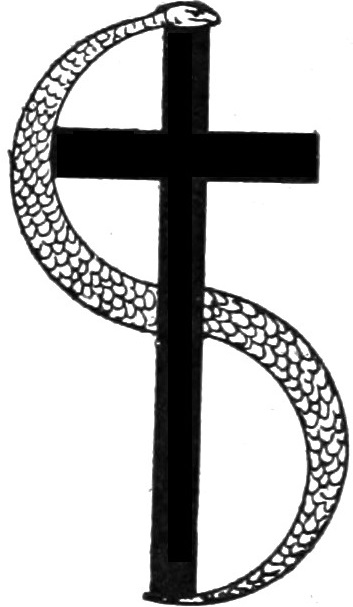
We have been looking at Jesus through his Jewish lens, and are going through every day of his Passion Week. Day 6 of that week, Friday, was Nisan 14- the Jewish Passover. A little review before covering the events of that Friday.
When Jesus entered Jerusalem on Sunday, Day 1 of that week, he stood on top of Mount Moriah, where 2000 years earlier Abraham had prophesied that there a great sacrifice ‘will be’ (future tense) provided. Then after his entry Jesus declared:
31 Now is the time for judgment on this world; now the prince of this world will be driven out.
John 12:31
The ‘world’ would revolve around the struggle about to take place on that Mountain, between himself and Satan, the ‘prince of this world’, who had entered Judas on Day 5 to strike the Christ.
The Last Supper
Friday, Day 6 of Passion week began with Jesus sharing his last supper with his disciples. We reckon this was on Thursday evening. But since the Jewish day started at sundown, their Friday began on what we would consider to be Thursday evening. Here is part of Jesus’ discourse at that meal.
27 Then he took a cup, and when he had given thanks, he gave it to them, saying, “Drink from it, all of you. 28 This is my blood of the covenant, which is poured out for many for the forgiveness of sins.
Matthew 26:27-28
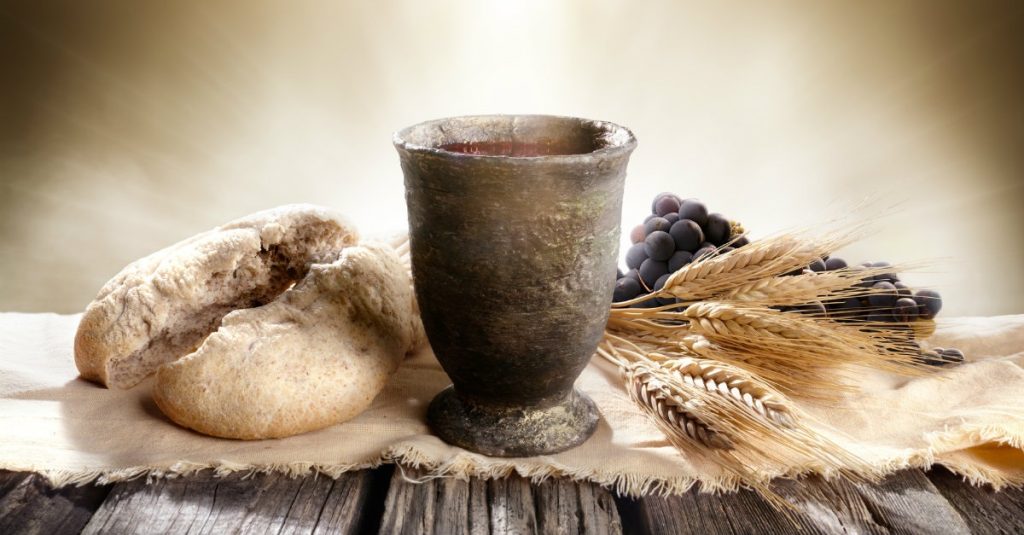
Then he explained through example and teaching how to love one another and he talked about God’s great love for us. This is all recorded here from the Gospel. Afterwards, he prayed for all his followers (read here).
In the Garden of Gethsemane
Then, he began his all-night vigil in the Garden of Gethsemene, just outside of Jerusalem.

Heinrich Hofmann, PD-US-expired, via Wikimedia Commons
36 Then Jesus went with his disciples to a place called Gethsemane, and he said to them, “Sit here while I go over there and pray.” 37 He took Peter and the two sons of Zebedee along with him, and he began to be sorrowful and troubled. 38 Then he said to them, “My soul is overwhelmed with sorrow to the point of death. Stay here and keep watch with me.”
Matthew 26:36-38
39 Going a little farther, he fell with his face to the ground and prayed, “My Father, if it is possible, may this cup be taken from me. Yet not as I will, but as you will.”
40 Then he returned to his disciples and found them sleeping. “Couldn’t you men keep watch with me for one hour?” he asked Peter. 41 “Watch and pray so that you will not fall into temptation. The spirit is willing, but the flesh is weak.”
42 He went away a second time and prayed, “My Father, if it is not possible for this cup to be taken away unless I drink it, may your will be done.”
43 When he came back, he again found them sleeping, because their eyes were heavy. 44 So he left them and went away once more and prayed the third time, saying the same thing.
45 Then he returned to the disciples and said to them, “Are you still sleeping and resting? Look, the hour has come, and the Son of Man is delivered into the hands of sinners. 46 Rise! Let us go! Here comes my betrayer!”
Matthew 26:36-46
The disciples could not stay awake and the vigil had just begun! The Gospel then describes how Judas betrayed him.
The arrest in the Garden

2 Now Judas, who betrayed him, knew the place, because Jesus had often met there with his disciples. 3 So Judas came to the garden, guiding a detachment of soldiers and some officials from the chief priests and the Pharisees. They were carrying torches, lanterns and weapons.
4 Jesus, knowing all that was going to happen to him, went out and asked them, “Who is it you want?”
5 “Jesus of Nazareth,” they replied.
“I am he,” Jesus said. (And Judas the traitor was standing there with them.)6 When Jesus said, “I am he,” they drew back and fell to the ground.
7 Again he asked them, “Who is it you want?”
“Jesus of Nazareth,” they said.
8 Jesus answered, “I told you that I am he. If you are looking for me, then let these men go.” 9 This happened so that the words he had spoken would be fulfilled: “I have not lost one of those you gave me.”
10 Then Simon Peter, who had a sword, drew it and struck the high priest’s servant, cutting off his right ear. (The servant’s name was Malchus.)
11 Jesus commanded Peter, “Put your sword away! Shall I not drink the cup the Father has given me?”
12 Then the detachment of soldiers with its commander and the Jewish officials arrested Jesus. They bound him 13 and brought him first to Annas, who was the father-in-law of Caiaphas, the high priest that year.
John 18:2-13
Jesus had gone to the garden to pray. There, Judas brought soldiers to arrest him. If we are threaten to get arrested, we might try to fight, run or hide. But Jesus did none of these. He admitted that he was the person they were looking for. His clear confession (“I am he”) startled the soldiers so his disciples escaped. Jesus submitted to arrest and they took him away for interrogation.
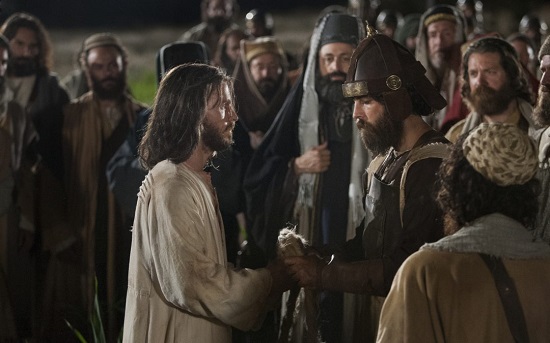
The First Interrogation
The Gospel records how they interrogated him:
19 Meanwhile, the high priest questioned Jesus about his disciples and his teaching.
20 “I have spoken openly to the world,” Jesus replied. “I always taught in synagogues or at the temple, where all the Jews come together. I said nothing in secret. 21 Why question me? Ask those who heard me. Surely they know what I said.”
22 When Jesus said this, one of the officials nearby slapped him in the face.“Is this the way you answer the high priest?” he demanded.
23 “If I said something wrong,” Jesus replied, “testify as to what is wrong. But if I spoke the truth, why did you strike me?” 24 Then Annas sent him bound to Caiaphas the high priest.
John 18:19-24
So they sent Jesus to the high priest for a second interrogation.
The Second Interrogation
There they interrogated him in front of all the leaders. The Gospel also recorded this second interrogation:

53 They took Jesus to the high priest, and all the chief priests, the elders and the teachers of the law came together. 54 Peter followed him at a distance, right into the courtyard of the high priest. There he sat with the guards and warmed himself at the fire.
55 The chief priests and the whole Sanhedrin were looking for evidence against Jesus so that they could put him to death, but they did not find any.56 Many testified falsely against him, but their statements did not agree.
57 Then some stood up and gave this false testimony against him: 58 “We heard him say, ‘I will destroy this temple made with human hands and in three days will build another, not made with hands.’” 59 Yet even then their testimony did not agree.
60 Then the high priest stood up before them and asked Jesus, “Are you not going to answer? What is this testimony that these men are bringing against you?” 61 But Jesus remained silent and gave no answer.
Again the high priest asked him, “Are you the Messiah, the Son of the Blessed One?”
62 “I am,” said Jesus. “And you will see the Son of Man sitting at the right hand of the Mighty One and coming on the clouds of heaven.”
63 The high priest tore his clothes. “Why do we need any more witnesses?” he asked. 64 “You have heard the blasphemy. What do you think?”
They all condemned him as worthy of death. 65 Then some began to spit at him; they blindfolded him, struck him with their fists, and said, “Prophesy!” And the guards took him and beat him.
Mark 14:53-65
Jesus calls himself the ‘Son of Man’ in this exchange. This is a title full of prophetic meaning, which we explore here.
However, the Jewish leaders condemned Jesus to death. But since Romans ruled them, only the Roman governor could approve an execution. So they took Jesus to the Roman Governor Pontius Pilate.
Jesus interrogated by the Roman Governor
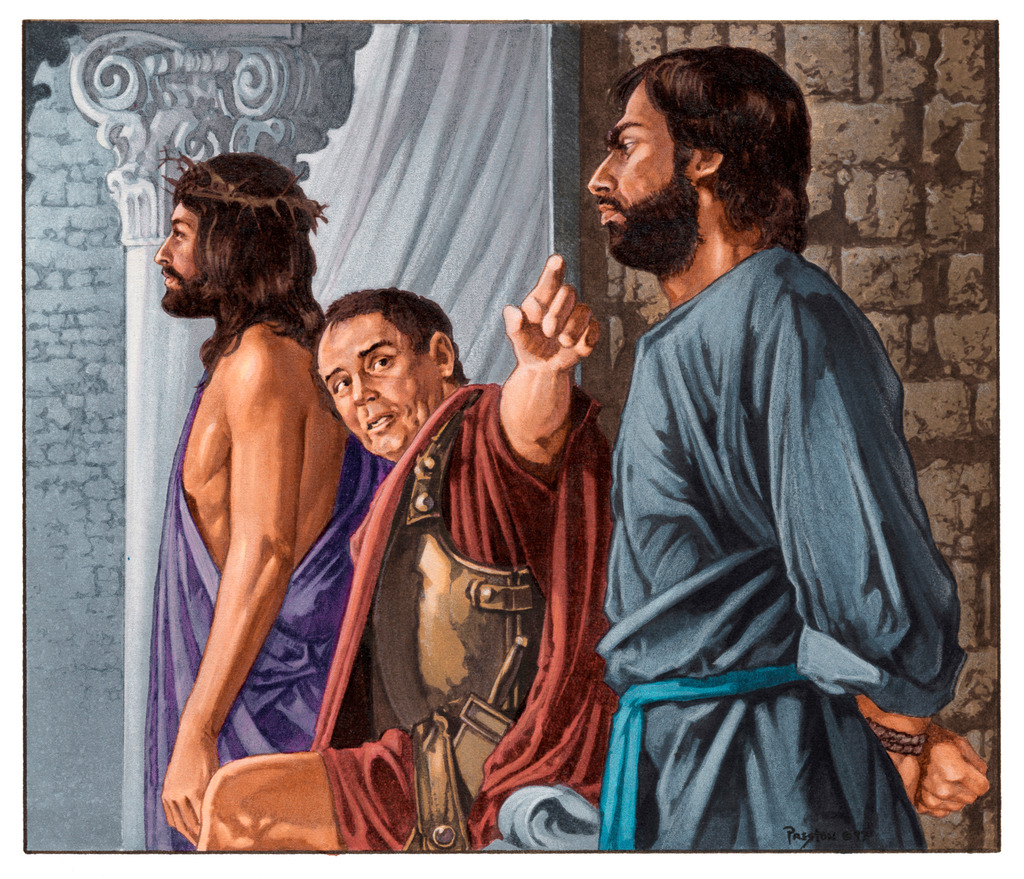
11 Meanwhile Jesus stood before the governor, and the governor asked him, “Are you the king of the Jews?”
“You have said so,” Jesus replied.
12 When he was accused by the chief priests and the elders, he gave no answer. 13 Then Pilate asked him, “Don’t you hear the testimony they are bringing against you?” 14 But Jesus made no reply, not even to a single charge—to the great amazement of the governor.
15 Now it was the governor’s custom at the festival to release a prisoner chosen by the crowd. 16 At that time they had a well-known prisoner whose name was Jesus Barabbas. 17 So when the crowd had gathered, Pilate asked them, “Which one do you want me to release to you: Jesus Barabbas, or Jesus who is called the Messiah?” 18 For he knew it was out of self-interest that they had handed Jesus over to him.
19 While Pilate was sitting on the judge’s seat, his wife sent him this message: “Don’t have anything to do with that innocent man, for I have suffered a great deal today in a dream because of him.”
20 But the chief priests and the elders persuaded the crowd to ask for Barabbas and to have Jesus executed.
21 “Which of the two do you want me to release to you?” asked the governor.
“Barabbas,” they answered.
22 “What shall I do, then, with Jesus who is called the Messiah?” Pilate asked.
They all answered, “Crucify him!”
23 “Why? What crime has he committed?” asked Pilate.
But they shouted all the louder, “Crucify him!”
24 When Pilate saw that he was getting nowhere, but that instead an uproar was starting, he took water and washed his hands in front of the crowd. “I am innocent of this man’s blood,” he said. “It is your responsibility!”
25 All the people answered, “His blood is on us and on our children!”
26 Then he released Barabbas to them. But he had Jesus flogged, and handed him over to be crucified.
Matthew 27:11-26
The Crucifixion, Death & Burial of Jesus

The Gospel then records the details of Jesus’ crucifixion.
27 Then the governor’s soldiers took Jesus into the Praetorium and gathered the whole company of soldiers around him. 28 They stripped him and put a scarlet robe on him, 29 and then twisted together a crown of thorns and set it on his head. They put a staff in his right hand. Then they knelt in front of him and mocked him. “Hail, king of the Jews!” they said. 30 They spit on him, and took the staff and struck him on the head again and again. 31 After they had mocked him, they took off the robe and put his own clothes on him. Then they led him away to crucify him.
Matthew 27:27-31
The Crucifixion of Jesus
21 A certain man from Cyrene, Simon, the father of Alexander and Rufus, was passing by on his way in from the country, and they forced him to carry the cross. 22 They brought Jesus to the place called Golgotha (which means “the place of the skull”). 23 Then they offered him wine mixed with myrrh, but he did not take it. 24 And they crucified him. Dividing up his clothes, they cast lots to see what each would get.
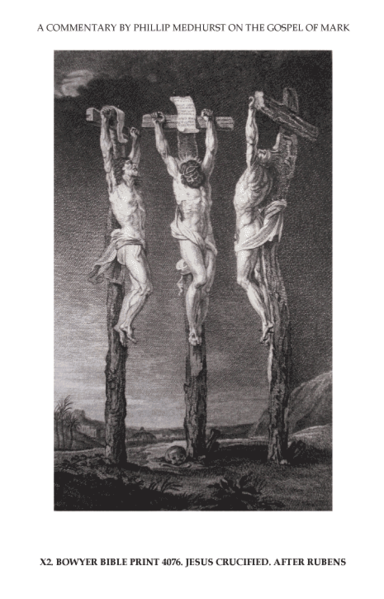
After Peter Paul Rubens , FAL, via Wikimedia Commons
25 It was nine in the morning when they crucified him. 26 The written notice of the charge against him read: the king of the jews.
27 They crucified two rebels with him, one on his right and one on his left. 29 Those who passed by hurled insults at him, shaking their heads and saying, “So! You who are going to destroy the temple and build it in three days, 30 come down from the cross and save yourself!” 31 In the same way the chief priests and the teachers of the law mocked him among themselves. “He saved others,” they said, “but he can’t save himself! 32 Let this Messiah, this king of Israel, come down now from the cross, that we may see and believe.” Those crucified with him also heaped insults on him.
The Death of Jesus
33 At noon, darkness came over the whole land until three in the afternoon. 34 And at three in the afternoon Jesus cried out in a loud voice, “Eloi, Eloi, lema sabachthani?” (which means “My God, my God, why have you forsaken me?”).
35 When some of those standing near heard this, they said, “Listen, he’s calling Elijah.”
36 Someone ran, filled a sponge with wine vinegar, put it on a staff, and offered it to Jesus to drink. “Now leave him alone. Let’s see if Elijah comes to take him down,” he said.
37 With a loud cry, Jesus breathed his last.
38 The curtain of the temple was torn in two from top to bottom. 39 And when the centurion, who stood there in front of Jesus, saw how he died, he said, “Surely this man was the Son of God!”
Mark 15:21-39
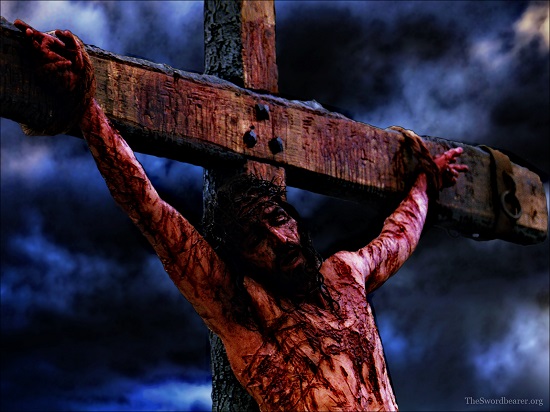
‘Pierced’ in his side
The Gospel of John records a fascinating detail of the crucifixion. It states:
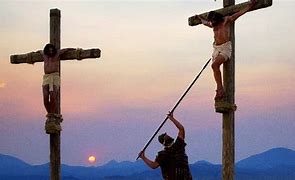
31 Now it was the day of Preparation, and the next day was to be a special Sabbath. Because the Jewish leaders did not want the bodies left on the crosses during the Sabbath, they asked Pilate to have the legs broken and the bodies taken down. 32 The soldiers therefore came and broke the legs of the first man who had been crucified with Jesus, and then those of the other. 33 But when they came to Jesus and found that he was already dead, they did not break his legs. 34 Instead, one of the soldiers pierced Jesus’ side with a spear, bringing a sudden flow of blood and water. 35 The man who saw it has given testimony, and his testimony is true. He knows that he tells the truth, and he testifies so that you also may believe.
John 19:31-35
John saw the Roman soldiers pierce Jesus’ side with a spear. Out came blood and water separated, indicating that he died of heart failure.
Jesus’ Burial
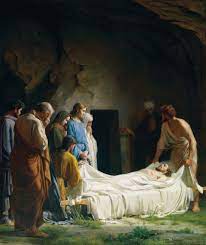
The Gospel records the final event that day – his burial.
57 As evening approached, there came a rich man from Arimathea, named Joseph, who had himself become a disciple of Jesus. 58 Going to Pilate, he asked for Jesus’ body, and Pilate ordered that it be given to him. 59 Joseph took the body, wrapped it in a clean linen cloth, 60 and placed it in his own new tomb that he had cut out of the rock. He rolled a big stone in front of the entrance to the tomb and went away. 61 Mary Magdalene and the other Mary were sitting there opposite the tomb.
Matthew 27: 57-61
Day 6 – Good Friday
Each day in the Jewish calendar began at sunset. So Day 6 began with Jesus sharing his last supper with his disciples. By the end of that day, he had been arrested, put on trial many times throughout the night, crucified, pierced with a spear, and buried. Pain, sorrow, humiliation and death marked this day and so people remember it in solemn contemplation. But this day is called ‘Good Friday’. But how can a day of betrayal, torture and death ever be called ‘good’? We get a hint in Psalm 22, written 1000 years before Jesus.
Why Good Friday and not ‘Bad Friday’?
Jesus’ drinking the ‘cup’ given to him by his Father saved the world. It fell on Nisan 14, the same as Passover day, when sacrificed lambs saved the people from death 1500 years before. It is the same day when Jews remembered their deliverance from the death. The timing of Jesus’ crucifixion was coordinated to the Jewish Passover. This is why Passover occurs very close to Good Friday, with the variance explained in the footnote below [1].
The Sign on Mount Moriah at Passover
The location of his crucifixion, was on Mount Moriah just outside the gates of Jerusalem. This was the place where 2000 years before, a lamb had substituted for Isaac when Abraham offered him to God. Jesus’ crucifixion so clearly coordinates by date to the sacrificed Passover lambs and by location to the lamb sacrificed for Isaac. This is a sign that Jesus’ crucifixion forms the centre of God’s plan. It is not mindless faith to believe this, but it simply allows these historical facts to speak their significance. The chart for Friday, Day 6 of Passion Week shows this coordination through the centuries.

Accounts of men conclude with their deaths, but not Jesus. Next came the Sabbath – Day 7.
[1] Jesus was crucified on Passover, Nisan 14 of the Jewish Lunisolar calendar. But the standard calendar used internationally is the Gregorian calendar with its 365.24 days per year. So in the 3rd Century CE, church officials devised another way to calculate Good Friday and Easter for this calendar. Easter Sunday was set to the first Sunday after the first full moon following the March 21 equinox. Since Jewish months are lunar, Nisan 14 will always land on a full moon. With the revised method to calculate the date of Easter, the festivals of Passover and Easter are usually close together. But they are not generally on the same day.